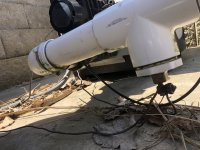- May 31, 2021
- 12
- Pool Size
- 33000
- Surface
- Plaster
- Chlorine
- Salt Water Generator
- SWG Type
- CircuPool RJ-60
It is best if you use the K-1766 Taylor Salt Test rather then salt test strips. The K-1766 is much more accurate and reliable.
Test you pool water before adding any salt and you may find you already have a significant salt level. You don't want to exceed the recommended salt level as to lower the salt will require draining water from the pool.
You can add the salt at anytime once you know how much to add. Before or after you install the cell.
The SWG is dual voltage so check what voltage it comes set for and adjust it if necessary.
The SWG should be connected to a timer to ensure the SWG is only powered when the pump is running unless you always run your pump 24/7. The flow switch should be a secondary safety device.

Thinking about the RJ-60 for my pool. Trying to squeeze it in between my heater and my caretaker system. Already have the check valve to the left of the caretaker. Do I need to move the check valve before the SWG?





